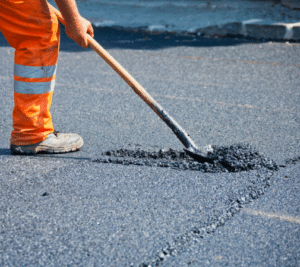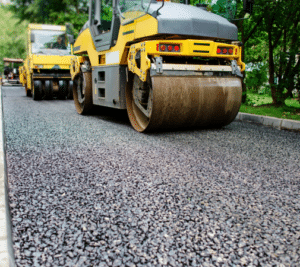Micro-surfacing is a popular pavement maintenance technique that has been used for decades. However, despite its long-standing presence in the industry, many misconceptions and myths still surround this process. If you’re considering micro-surfacing for your road or parking lot, separating fact from fiction is essential. This article will debunk ten myths about micro-surfacing and provide the accurate information you need to make an informed decision.
What is Micro Surfacing?
Micro-surfacing is a road maintenance technique that involves the application of a thin layer of asphalt emulsion mixed with aggregate to a road’s surface. This process helps restore the smoothness and integrity of the road and provides protection against further deterioration. Micro-surfacing is commonly used to address issues such as cracking, rutting, and oxidation on roads. It is a cost-effective and efficient method of road maintenance that can extend the lifespan of a road and improve driving conditions for motorists.
Despite the many benefits of micro-surfacing, some common myths about it can be misleading. Let’s take a look at ten of them.
Myth 1: Micro Surfacing is Unreliable
One of the most common misconceptions about micro-surfacing is that it is unreliable and unable to withstand extreme weather conditions. However, micro-surfacing has proven to be a reliable road maintenance solution and can effectively withstand harsh weather conditions. It effectively protects roads from further deterioration due to water, sun, or other environmental factors.
Myth 2: Micro Surfacing is Difficult to Install
Another misconception about micro-surfacing is that it is difficult to install. While it may require special equipment and expertise, the micro-surfacing installation process is relatively straightforward. The technique has been used in road construction for many years and requires minimal manual labor.
Myth 3: Micro Surfacing is Expensive
Many people mistakenly believe that micro-surfacing is an expensive solution. In reality, micro surfacing can be very cost-effective, especially compared to other road maintenance methods such as repaving or resurfacing. The cost savings of micro surfacing can be further increased by using recycled materials instead of new ones.
Myth 4: Micro Surfacing is Unattractive
Another myth about micro-surfacing is that it is unattractive and looks terrible. On the contrary, modern micro-surfacing techniques can be used to give roads a fresh look and improve their aesthetic appeal.
Myth 5: Micro Surfacing is Not Durable
Another myth about micro-surfacing is that it is not durable and will only last for a short time. This is simply not true. Micro-surfacing can protect roads from further damage due to weathering or traffic and can last up to 10 years or more. The durability of micro-surfacing depends on the quality of materials used and the expertise of those installing it.
Myth 6: Micro Surfacing is Unsafe
Another myth about micro-surfacing is that it is unsafe for drivers due to the slick surface it creates. In reality, micro-surfacing improves road traction, providing an improved driving experience by reducing hydroplaning and skidding.
Myth 7: Microsurfacing Is Only Effective On Asphalt Roads
Another common misconception about micro surfacing is that it can only be used on asphalt roads. This is false; micro surfacing can also be used effectively on concrete surfaces.
Myth 8: Micro Surfacing is a Waste of Time
Many people mistakenly believe that micro-surfacing is a waste of time and money, as it doesn’t address the underlying problems with the road. On the contrary, micro surfacing can be an effective solution to road issues such as potholes, ruts, and cracking. It provides an effective way to extend the roads’ life while improving their appearance.
Myth 9: Micro Surfacing Is The Same As Slurry Seal
One of the biggest misconceptions about micro surfacing is that it is the same as a slurry seal. This is not true. While both are road maintenance techniques, they have some significant differences. For example, slurry seal uses a thicker mix of asphalt and stones than micro surfacing and has a more textured finish. Slurry seal is also better suited for larger road repair projects, while micro surfacing can patch smaller areas.
Myth 10: Micro Surfacing is Difficult to Maintain
Contrary to popular belief, micro surfacing is relatively easy to maintain. Proper maintenance ensures the surface can be kept in good condition for up to ten years or more. Regular inspections should be conducted to identify potential problems, and corrective measures should be immediately taken. Additionally, regular sweeping should be done to remove any debris that may collect on the surface.
Micro-surfacing is an effective and efficient road maintenance technique that can help extend a road’s lifespan. As such, it can be an excellent investment for municipalities and other organizations looking to protect their roads from further deterioration. Despite its many advantages, there are still some misconceptions about micro surfacing that can lead people astray. By understanding the truth behind these common myths, individuals and organizations
Wrapping Up
Micro-surfacing is an effective road maintenance technique that can help extend the roads’ lifespan and improve driving conditions for motorists. Despite common misconceptions, micro surfacing is a reliable, cost-effective solution that can withstand extreme weather conditions and last for many years.
If you’re looking for a reliable and cost-effective solution to maintain your roads, contact Saguaro Asphalt today! Our experienced team of professionals can provide you with the expertise and materials needed to complete a micro surfacing project quickly and efficiently, so you can enjoy durable and attractive roads for years to come.



